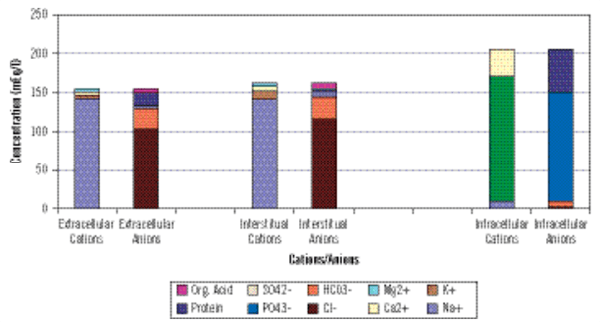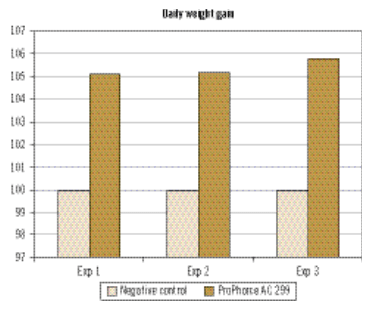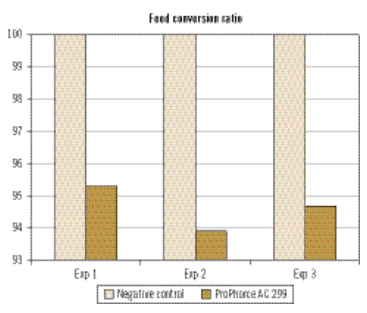Dietary electrolyte balance
Advantages of optimising dietary electrolyte balance
Published: June 18, 2012
By: Marc Kinjet (Perstorp Performance Additives)
For more than a century nutritionists have been interested in the effect that dietary electrolyte balance has on animal health and performance. It is nowadays well established that the dietary electrolyte balance represents a challenging area that allows nutritionists to adapt diets of production animals according to their physiological stage and also to environmental challenges such as heat stress.
Electrolytes have four important physiological functions in the body, namely they:
- are essential minerals in many biochemical reactions
- are very important in controlling the movement of water over the membrane, thereby controlling the osmotic pressure in cells
- maintain the acid-base balance
- conduct electrical potentials over biological membranes
As is shown in Figure 1 there is a difference in the electrolyte balance between the three main fluid compartments of the body. In the extracellular fluid the dominant cation is Sodium (Na+ ), whilst the most important anion is Chloride (Cl- ). Due to the important role of active transport processes over biological membranes the most abundant cation in intracellular fluids is Potassium (K+ ), whilst the most influential anion in the intracellular fluid is Phosphate ( HPO3- ).
Figure 1 - The electrolyte balances in various body fluids

The transport of minerals across biological membranes is associated with active transport systems. For the whole body as such the electrolyte balance is maintained by oral intake and renal (urine) excretion.
Figure 2 - The symport transport of Sodium (Na+) and glucose (Molecular Biology of the Cell, Alberts et al., 2002)

Role of sodium in nutrient transport
Sodium is the most important mineral in the active transport processes of important nutrients such as glucose and amino acids across biological membranes. As an example, glucose uptake from the intestines is made possible by the active transport Na+ - K+ -ATP-ase system, which maintains high sodium levels in the extracellular fluid and the active symport 1 transportation (Figure 2) of sodium and glucose at the apical surface. Meanwhile for the uptake of amino acids similar symport transport systems are being used to transport amino acids across the apial membrane of intestinal enterocytes. Most likely this important role of sodium in the intestinal absorption of crucial nutrients contributes to the reported improvement of growth rate and feed conversion ratio when the dietary electrolyte balance was set at +220-+250 mEq/kg in both swine and broiler diets.
Figure 3 - Improvement of daily weight gain of post weaning piglet given 1.1% ProPhorce AC 299 (Schothorst Feed Research 2005 – 2009)

Figure 4 - Improvement of FCR of post weaning piglets fed with 1.1% ProPhorce AC 299 (Schothorst Feed Research 2005 -2009)

Dietary electrolyte balance
The dietary electrolyte balance is the balance between positively charged ions in the feed (Cations) and the negatively charged ions (Anions). As is shown in Figure 1 many minerals play a role in the dietary electrolyte balance (dEB), but it is also clear that the major effect on animal physiology is given by a smaller number of relative abundant minerals and therefore the dietary Electrolyte Balance can be calculated as follows:
Na + /0.023 + K + /0.039 – Cl - /0.0355 – S 2- /0.016 = dEB (meq/kg feed)
Sulphur is relatively important in liquid diets with a high content of liquid by-products.
Positive dietary electrolyte balance
In most cited literature and also in trials conducted by Perstorp, it is clear that a positive dEB has a positive effect on animal health and performance. Those effects are mainly due to the fact that in metabolic processes the blood is acidified and when the dEB is positive those metabolites are quickly buffered. Further nutrient uptake, as explained ealier, is improved when the sodium content of the diet is optimised. The effects that Perstorp research showed were predominantly seen in a significantly improved feed conversion. Other researchers have found various benefits from a positive dietary electrolyte balance, such as an improved daily gain and improved nutrient digestibility.
New development
During the past five years Perstorp has worked hard to develop a product that combines the ability to optimise the dEB with the ability to inhibit the growth of pathogenic bacteria. Named ProPhorce AC 299, this mix has shown in various independent trials that it enhances the growth rate of early weaned piglets and that the mechanism of the improved feed utilisation is based on the higher dEB value enforced by elevated Sodium levels. In the three experiments shown (Figure 3 and 4) the dietary electrolyte balance was increased from + 220 mEq/kg in Experiment 1 to + 270 mEq/kg in Experiment 3. In the control group this was achieved by adding sodium bicarbonate, whilst the experimental group received ProPhorce AC 299.
The better feed utilisation was clearly shown in a significant improvement of feed conversion rate in all three experiments.
Conclusion
It can be concluded that the improvement of dEB by means of ProPhorce AC 299 leads to better growth performance in piglets by means of an improved feed utilisation due to a better active transport facilitated nutrient uptake in the small intestines.
Related topics:
Authors:
Perstorp Feed & Food
Recommend
Comment
Share

Would you like to discuss another topic? Create a new post to engage with experts in the community.






